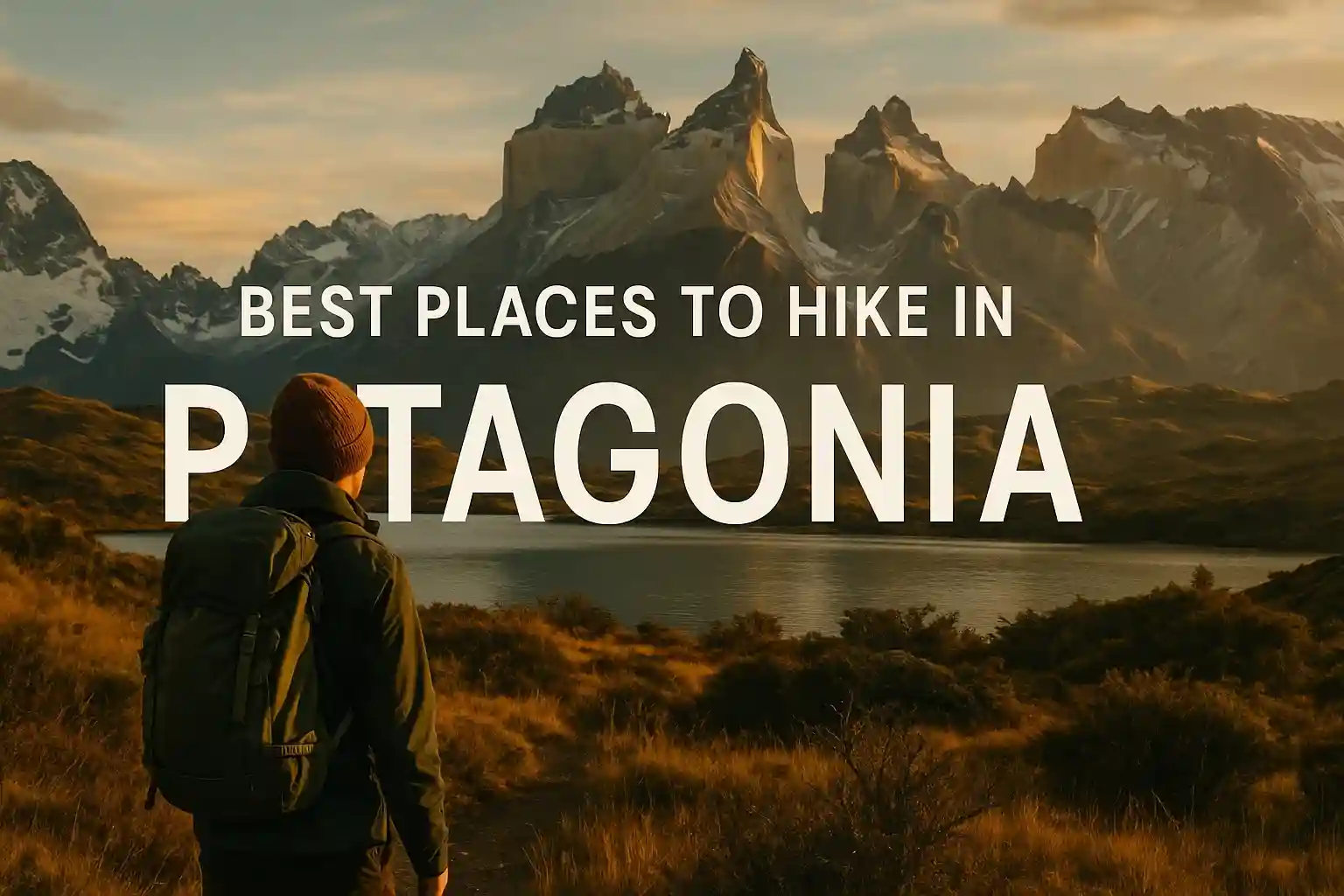
Planning a hiking trip to Patagonia? Few places on earth offer such a mix of wild beauty and accessible adventure. Imagine standing beneath the granite spires of Fitz Roy, tracing the edge of a glacier, or wandering through valleys where guanacos graze and condors soar overhead. Patagonia is vast, but that does not mean planning your hikes has to feel overwhelming.
The good news is that some of the world’s best trails are found here, ranging from famous routes like the Torres del Paine W Trek to hidden favorites in Bariloche and Ushuaia. Whether you are looking for a challenging multi-day trek or a day hike with unforgettable views, this guide highlights the places worth prioritizing so you can spend less time researching and more time exploring.

Reviewed with our Argentina specialist to ensure local cultural and travel insights.
Patagonia is one of those rare places where every trail feels like a postcard. For hikers, this region divided between Argentina and Chile is more than just scenic; it is a playground of both bucket-list treks and little-known gems.
The direct answer: If you love dramatic landscapes and world-class trails, Patagonia is hard to beat.
On the Argentina side you will find El Chaltén, often called the country’s trekking capital, with iconic routes to Fitz Roy and Cerro Torre. In Chile, Torres del Paine National Park offers the famous W and O treks. Add in options from El Calafate’s glacier hikes to Bariloche’s alpine routes and Ushuaia’s remote circuits, and you get a region that delivers something for every hiking style, from casual day-walkers to seasoned backpackers.
If you only have a few minutes to plan, here are the hikes that travelers consistently rate as the best in Patagonia.
These hikes cover the highlights most people dream about when they think of Patagonia, while also including a few lesser-known gems for those who want to go beyond the usual routes.
| Trail | Location | Highlight |
|---|---|---|
Laguna de los Tres Fitz Roy summit viewpoint |
El Chaltén, Argentina | A classic route to the panoramic lookout for Mount Fitz Roy. |
Laguna Torre Cerro Torre glacier lagoon |
El Chaltén, Argentina | Scenic valley hike ending at a dramatic glacier-fed lagoon. |
Torres del Paine W Trek Multi-day valleys and spires |
Magallanes, Chile | Iconic multi-day trek through valleys, glaciers, and granite towers. |
Perito Moreno Glacier Mini Trek Walk on blue ice |
El Calafate, Argentina | Guided microspikes experience walking directly on a living glacier. |
O Circuit Full park loop |
Torres del Paine, Chile | Extended backcountry loop for a complete Torres del Paine immersion. |
Dientes de Navarino World’s southernmost trek |
Puerto Williams, Chile | Remote, rugged circuit among tooth-like peaks near the end of the world. |
Refugio Otto Meiling Hut between glaciers |
Bariloche, Argentina | Alpine hike to a refuge perched between the Frías and Alerce glaciers. |
Laguna del Caminante Wild Fuegian landscapes |
Ushuaia, Argentina | Solitary southern trail to a high Andean lagoon amid peat and lenga. |
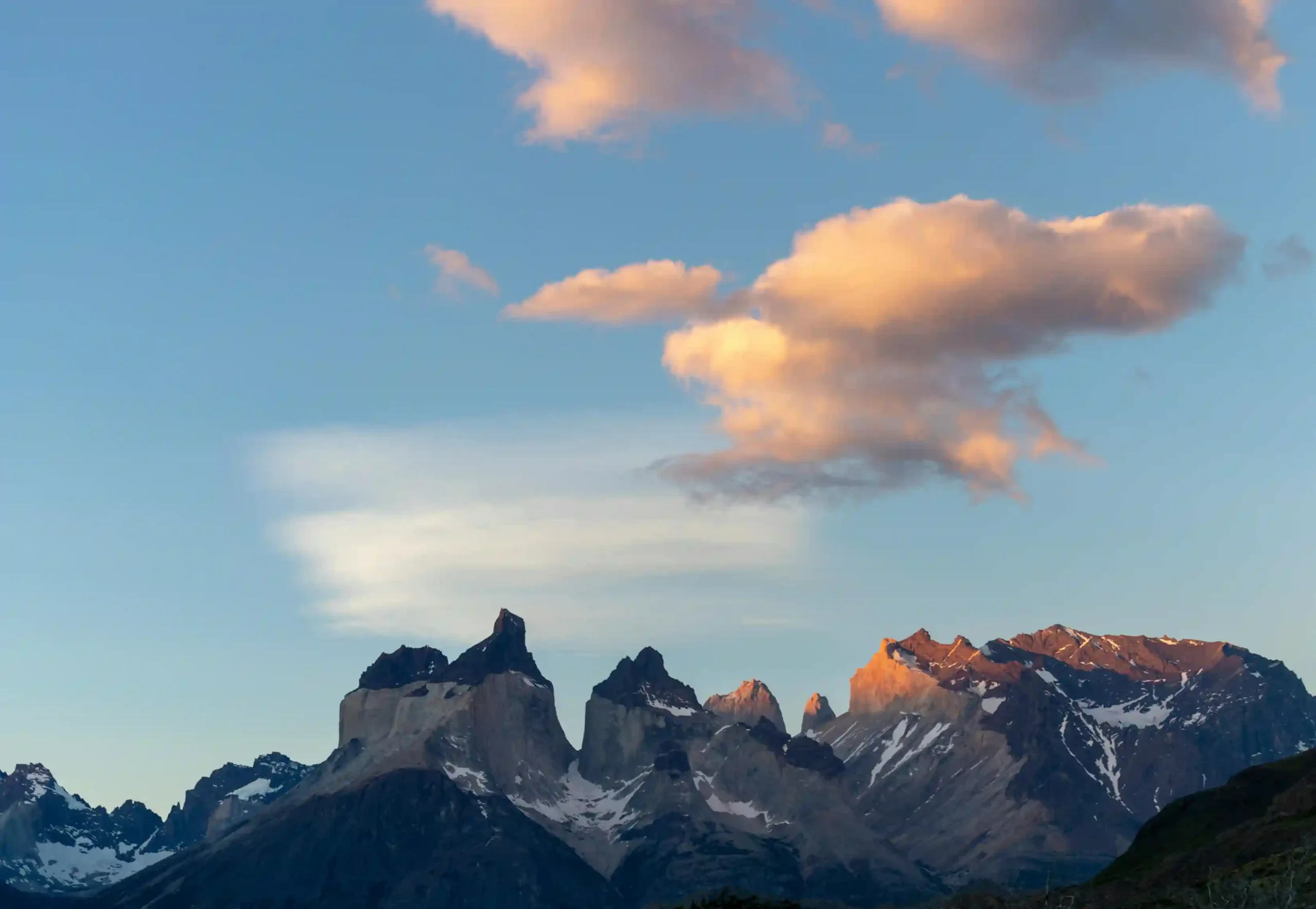
If you want the quintessential Patagonia trek, the W Trek in Chile’s Torres del Paine National Park is it. This four to five day route winds through the park’s most famous landscapes, including the Grey Glacier, the dramatic French Valley, and the base of the Torres towers themselves.
The direct takeaway: the W Trek is the most popular multi-day hike in Patagonia and a rite of passage for many hikers.
It is well-marked, accessible for intermediate hikers with good fitness, and offers options to stay in refugios or camp along the way. The biggest challenge is not the trail itself but the planning — permits and accommodations sell out quickly in high season. For most travelers, booking months ahead is essential.
Best season: December through March, when days are long and weather is relatively stable.
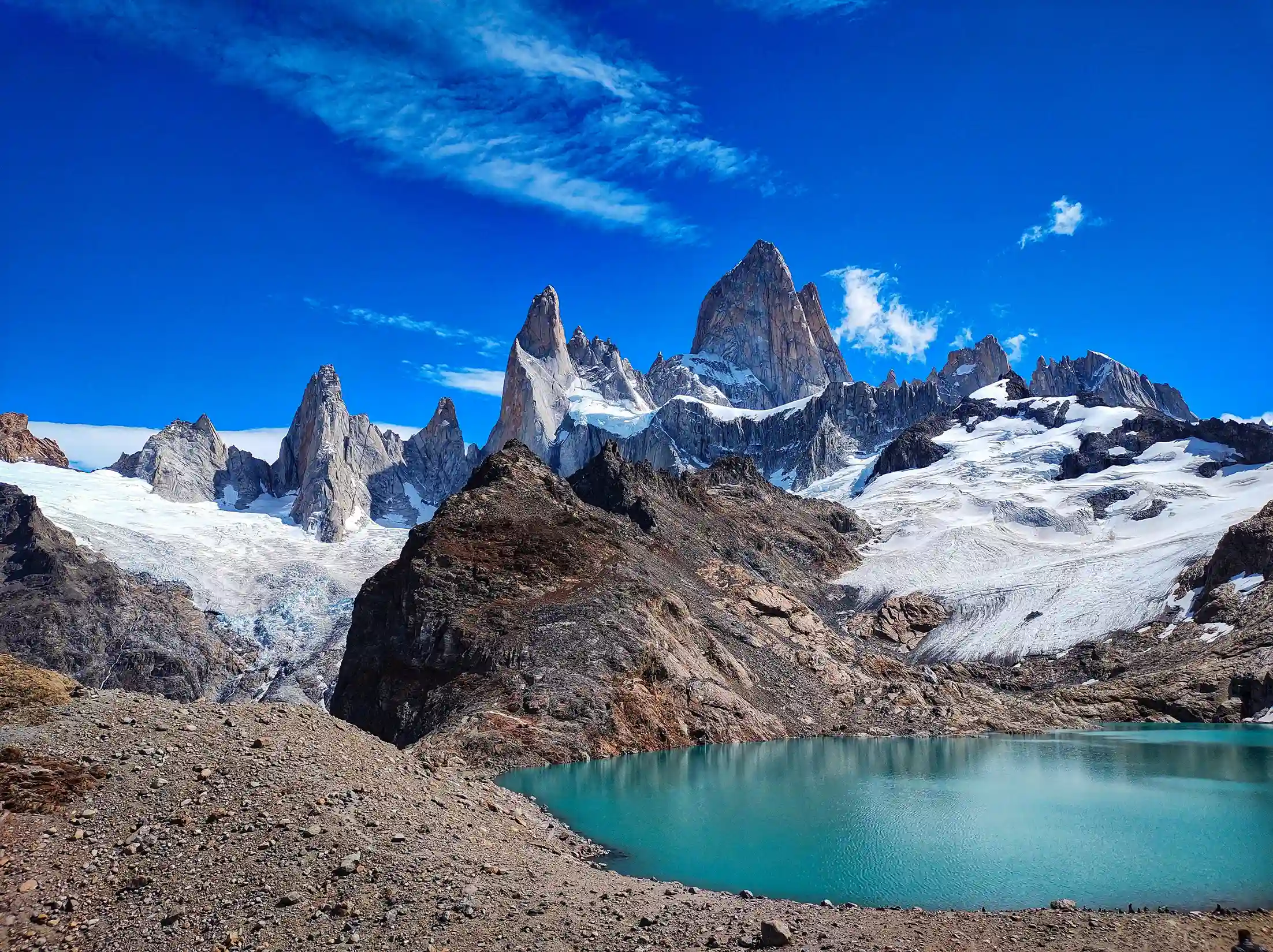
This is the hike that puts you face to face with Mount Fitz Roy, Patagonia’s most photographed peak. It is a full-day trail, usually taking eight to ten hours round trip, with the final climb being steep but worth every step.
Laguna de los Tres is the most famous day hike in Argentine Patagonia and a must if you are visiting El Chaltén.
Along the way you pass through lenga forests, cross streams, and catch glimpses of the Fitz Roy massif. The real payoff comes at the top, where the turquoise waters of the lagoon sit beneath Fitz Roy’s jagged granite spires. Sunrise is the most magical time to be there, though it requires starting the hike very early in the dark or camping nearby.
Best season: November through March, when the trail is free of snow and days are long.
If Laguna de los Tres is about Fitz Roy, this trail is all about Cerro Torre. The hike takes around seven to eight hours round trip and is less steep than Fitz Roy’s route, making it a little easier on the legs while still delivering unforgettable views.
Laguna Torre is the best way to see Cerro Torre, one of Patagonia’s most dramatic and elusive peaks.
The trail winds through valleys and forests before opening up to a glacial lagoon, often dotted with floating icebergs. On clear days you can see the sharp spire of Cerro Torre rising behind the glacier, though many hikers joke that the mountain hides behind clouds more often than not. Either way, the setting is spectacular and worth the effort.
Best season: Summer months (December to March) offer the best chance of clear skies.
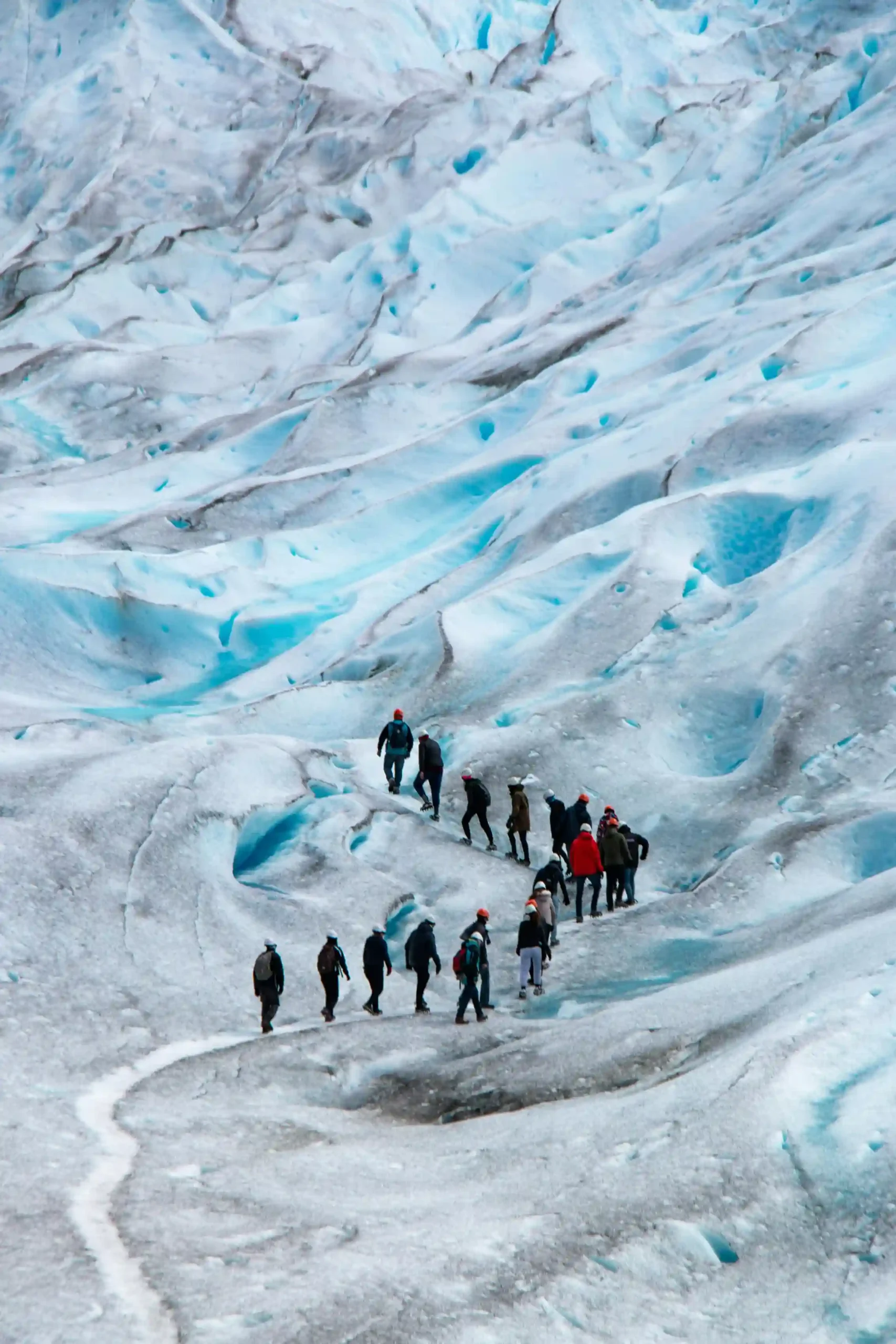
Most hikes in Patagonia take you to viewpoints of mountains or lakes, but this one lets you walk directly on a glacier. The Perito Moreno Glacier near El Calafate is one of the few in the world where guided trekking is allowed.
The mini trek is a rare chance to strap on crampons and explore a living glacier up close.
The experience usually lasts half a day. After a short boat ride, guides lead you onto the ice where you weave between crevasses and bright blue meltwater pools. It is not physically demanding, but it does feel like stepping into another world. The trek is always paired with time at the main viewing platforms, which give a front-row look at the glacier’s massive ice wall.
Best season: Accessible from September through May, though summer months have the most comfortable conditions.
For hikers who want the full Torres del Paine experience, the O Circuit delivers. This route circles the entire park, taking seven to nine days to complete, and covers both the highlights of the W Trek and remote backcountry that far fewer visitors see.
The O Circuit is Patagonia’s most complete multi-day trek, combining iconic views with true wilderness.
The trail takes you past Grey Glacier, through the French Valley, and up to the Torres base, just like the W Trek. But it also includes the quieter northern side of the park, where wide valleys, lenga forests, and high passes create a more rugged, off-the-grid atmosphere. Campsites are basic, distances are longer, and the weather can be challenging, but the reward is an unmatched sense of immersion in Patagonia’s wild landscapes.
Best season: December through March, when campsites are open and weather windows are more favorable.
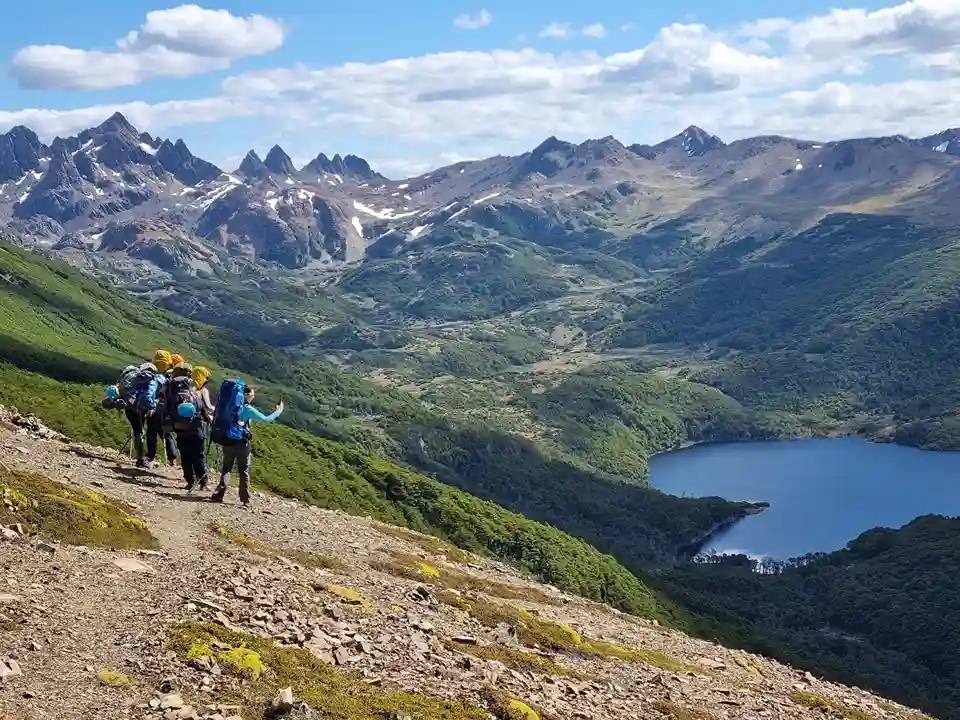
If you are looking for the ultimate adventure, the Dientes de Navarino trek is as far south as hiking goes. Starting from Puerto Williams on Navarino Island, this four to five day circuit takes you through rugged valleys, alpine lakes, and jagged peaks that feel completely untouched.
Dientes de Navarino is the southernmost multi-day trek in the world, offering raw wilderness for experienced hikers.
This is not a beginner-friendly trail. The terrain is rough, the weather is unpredictable, and navigation can be tricky. But for those prepared to take it on, the reward is a landscape unlike anywhere else in Patagonia — wild, remote, and almost entirely empty of crowds. It is the kind of hike that feels more like an expedition than a holiday.
Best season: December through March, though even in midsummer the weather can be harsh.
Pick from our curated packages for an easy start, or work with our specialists to design a custom itinerary that fits your group perfectly.
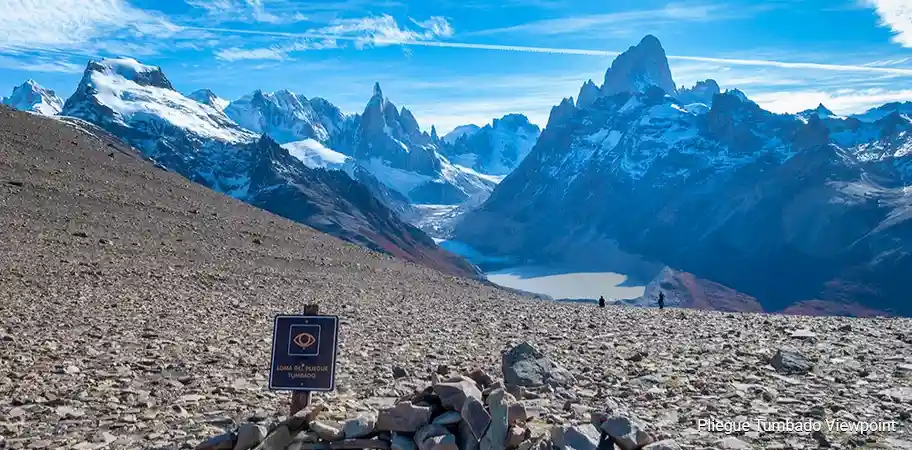
For hikers who want the sweeping views without the heavy crowds, Loma del Pliegue Tumbado is a top pick. The trail climbs steadily for about six to seven hours round trip, rewarding you with a panoramic perspective of Fitz Roy, Cerro Torre, and the surrounding valleys.
This hike offers some of the best wide-angle views in El Chaltén and feels far less crowded than Fitz Roy’s trail.
Because the route is exposed, it is best attempted on a clear day. When the skies cooperate, you can see glaciers, lagoons, and mountains stretching in every direction. The climb is steady but manageable for intermediate hikers, and the sense of scale at the top makes it one of Patagonia’s most underrated trails.
Best season: Summer months, ideally on a calm and cloud-free day.
If you are ready for a challenge, the Huemel Circuit is one of Patagonia’s toughest and most rewarding treks. This four-day loop near El Chaltén takes you through remote passes, hanging glaciers, and dramatic views over the Southern Patagonian Ice Field.
The Huemel Circuit is for experienced hikers who want a true backcountry adventure away from the crowds.
Unlike the well-marked Fitz Roy trails, the Huemel requires self-sufficiency. The route includes steep ascents, river crossings, and sections where navigation can be difficult. Many hikers carry camping gear and food for the entire trek, and some hire local guides to handle the logistics. The payoff is immense: glacier panoramas, star-filled nights, and a sense of solitude that few trails in Patagonia can match.
Best season: January and February are ideal, when weather is most stable and days are long.
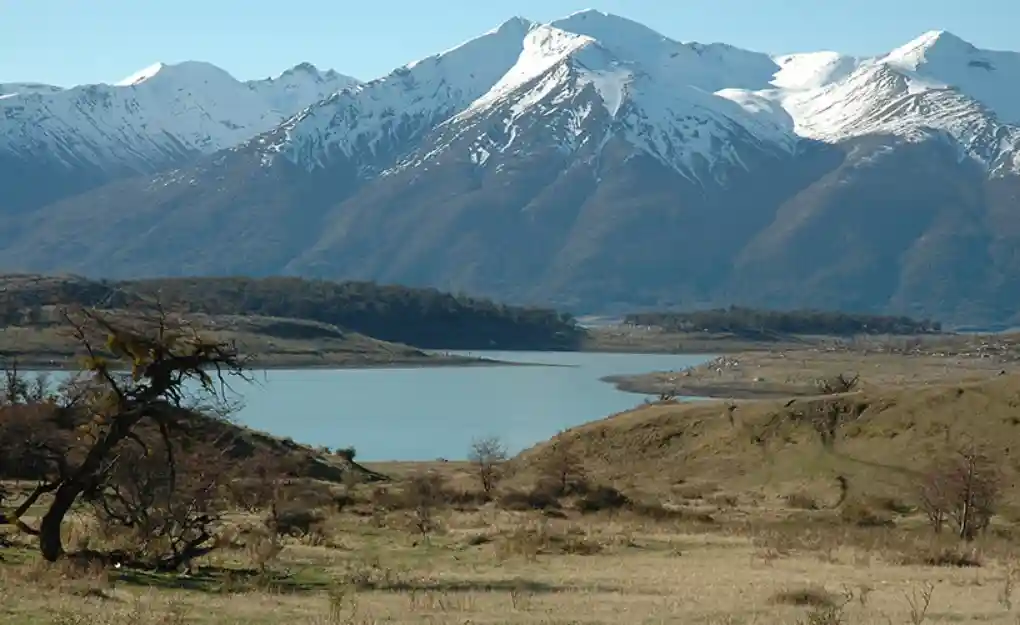
Just outside El Calafate lies a quieter alternative to the crowded Perito Moreno viewpoints. The trail up Cerro Cristal begins at Lake Roca and climbs steadily to a ridge that delivers sweeping views over the glacier and the vast Lago Argentino.
Cerro Cristal is a lesser-known hike that rewards you with panoramic glacier and lake vistas without the heavy crowds.
The trail is not as famous as Fitz Roy or Torres del Paine, but that is part of its charm. Most visitors to El Calafate only see Perito Moreno from the boardwalks, so hiking here offers a more active way to take in the scenery. It is a moderately challenging climb but well within reach for hikers with reasonable fitness.
Best season: Summer months, when skies are clear and trails are accessible.
North of El Chaltén, the Lago del Desierto area offers a quieter experience compared to the town’s busier trails. From the lake, you can follow a short but rewarding path to the Huemul Glacier, tucked away in a valley with far fewer visitors.
This hike combines a scenic mountain lake with a compact trail to a glacier, making it one of the easier yet rewarding outings near El Chaltén.
The hike is shorter than the big-name treks, usually a few hours round trip, and is accessible for most fitness levels. The setting feels remote and peaceful, framed by forests and ice. For those with extra time, exploring the Lago del Desierto area by boat or road also adds another layer to the experience.
Best season: December through March, though trails can usually be accessed from late spring to early fall.
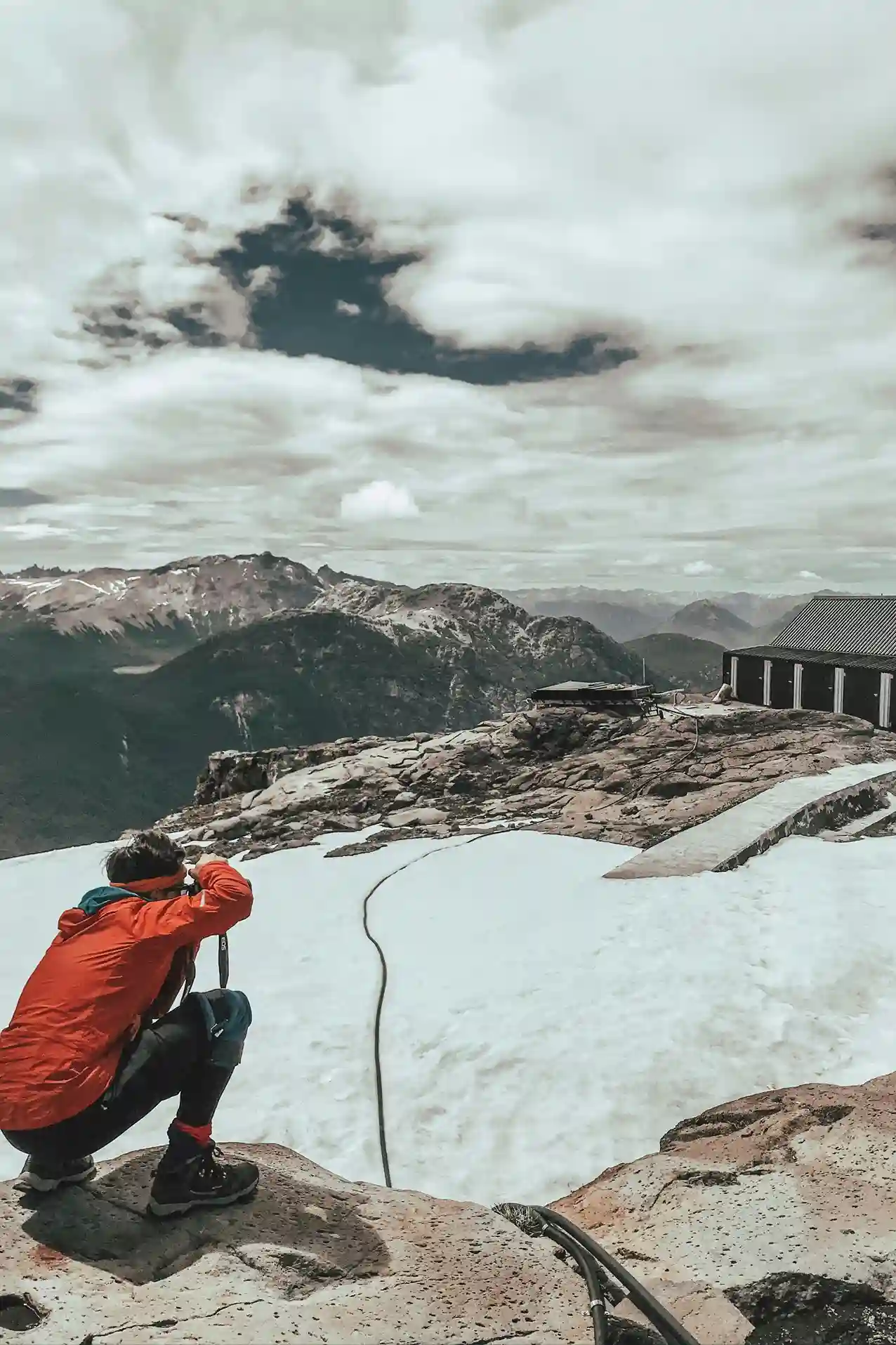
Bariloche is better known for its lakes and chocolate shops, but it also hides one of Patagonia’s most unique hikes. The trail to Refugio Otto Meiling takes you through alpine forests and up to a mountain hut dramatically perched between two glaciers.
This hike gives you the rare chance to overnight at a refuge surrounded by ice and peaks.
The hike usually takes six to seven hours one way, so many travelers stay at the hut and return the next day. The views are spectacular, especially at sunrise and sunset when the surrounding peaks glow pink. It is a moderate to challenging hike, but the payoff is the experience of feeling suspended between two massive rivers of ice.
Best season: December through March, when the hut is open and the trail is safe to access.
At the southern tip of Argentina, Ushuaia offers some of Patagonia’s wildest trails. Among them, Laguna del Caminante stands out as a rugged yet rewarding trek. The route takes most of a day, crossing valleys and forests before opening up to a remote lagoon surrounded by peaks.
Laguna del Caminante is one of the best hikes in Ushuaia for those who want a taste of true southern wilderness.
The trail is less maintained than those in El Chaltén or Torres del Paine, which adds to its sense of adventure. Conditions can be muddy, weather is unpredictable, and navigation may require extra attention. But the payoff is solitude, pristine scenery, and the feeling of being at the edge of the world.
Best season: January through March, though hikers should always prepare for fast-changing conditions.
The short answer: most travelers do best with seven to fourteen days. That gives enough time to enjoy a mix of iconic hikes and lesser-known gems without feeling rushed.
Here is how trip length usually shapes your hiking options:
Trying to cover both Argentina and Chile in less than a week often feels rushed. It is better to choose one region and do it well than to spend most of your time on buses and border crossings.
Not sure how to balance your time between Argentina and Chile? Our Wonders of Patagonia tour through Argentina and Chile is built around the region’s most iconic hikes, so you can see Fitz Roy, Torres del Paine, and more without worrying about the logistics.
The best time to hike in Patagonia is from November through March, when summer brings long daylight hours, milder temperatures, and better access to trails.
Here is what each part of the season offers:
Outside these months, many routes are either closed or too risky due to snow, high winds, and unpredictable storms. Shoulder months like October and April can be tempting for those seeking solitude, but hikers should be prepared for limited services and challenging conditions.
Hiking in Patagonia is unforgettable, but the region’s sheer size and unpredictable weather make preparation essential. Even in summer, you can face strong winds, sudden rain, and rapid temperature shifts that catch unprepared travelers off guard. A little planning goes a long way.
Gear to bring
Logistics to plan ahead
Fitness to consider
Even the “easy” hikes here involve some elevation gain or long distances. Training with day hikes at home will make the experience more enjoyable once you arrive.
Patagonia rewards those who prepare, both with gear and with realistic expectations.
Patagonia has no shortage of world-class trails, but the right choice depends on the kind of adventure you want. If you are chasing the classics, hikes like Laguna de los Tres, Laguna Torre, and the W Trek deliver the views you have seen in postcards. For those who want something longer and more demanding, the O Circuit, Huemel Circuit, and Dientes de Navarino push the limits while offering unmatched wilderness. And if hidden gems call to you, trails around Bariloche, Ushuaia, and El Calafate prove that Patagonia’s magic is not limited to its most famous spots.
The direct takeaway: there is no single “best” hike in Patagonia, but there is a perfect hike for every traveler.
Wherever you decide to lace up your boots, Patagonia offers landscapes that will stay with you long after you leave.